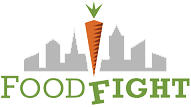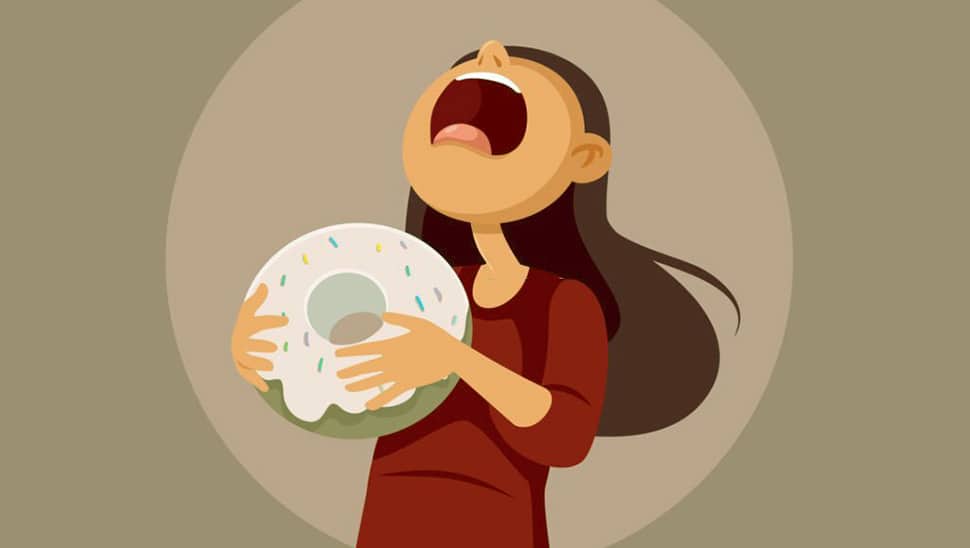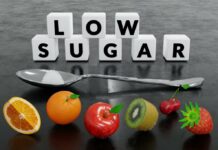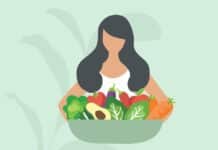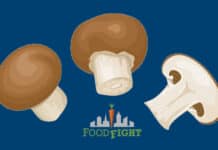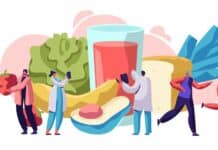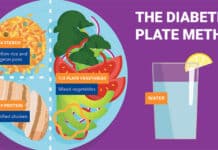Here's an easy way to tell if you're addicted to sugar.
After a healthy, low-carbohydrate meal like fish, vegetables, and a salad, you still feel hungry and can't stop thinking about food until you eat a slice or two of bread, a sugary dessert, or a glass of soda.
If you've provided your body with a wonderful variety of nutrients and plenty of calories, your brain shouldn't be telling you that you're still hungry. If it is, then you might be a sugar addict.
The brain loves sugar (glucose). Suppose you're addicted to sugar from consuming lots of processed carbohydrates like bread, pasta, and cereal for years and years. In that case, your brain will falsely send you hunger signals when there is no glucose easily available for energy.
Sugar addicts want a snack soon after eating a meal, have noticeable moments of fatigue during the day, and don't think a salad for dinner is “real food.”
An addiction to sugar leads to overeating, weight gain, insulin resistance, and a multitude of other health problems.
Is Sugar Really Addictive?
When I say “sugar addiction,” I'm not only talking about sweets like candy and cake. All carbohydrates are broken down into glucose (sugar) during digestion, so to your body, carbohydrates = sugar.
The hardest part of changing one's diet is often the sugar/carb cravings that come with it, but is sugar actually an addictive substance?
Dr Robert Lustig, Professor of Pediatrics in the Endocrine Division at the University of California, says this about sugar:
“The brain's pleasure center, called the nucleus accumbens, is essential for our survival as a species… Turn off pleasure, and you turn off the will to live. But long-term stimulation of the pleasure center drives the process of addiction. When you consume any substance of abuse, including sugar, the nucleus accumbens receives a dopamine signal, from which you experience a pleasure. And so you consume more.
The problem is that with prolonged exposure, the signal attenuates, gets weaker. So you have to consume more to get the same effect — tolerance. And if you pull back on the substance, you go into withdrawal. Tolerance and withdrawal constitute addiction. And make no mistake, sugar is addictive.”
This is why food cravings are so hard to overcome.
Are Sugar-Free Products the Answer?
Our addiction to sugar and the rise of sugar-related disease has caused an avalanche of “sugar-free” foods marketed as “safe” alternatives for diabetics and those wanting to lose weight, but these products are deceptively harming people.
People trying to avoid sugar for health reasons should stay away from sugar-free labels at all costs. It is unethical and dangerous to market these foods to diabetics, those with insulin resistance, or people with metabolic disorders.
Sugar-free foods and snacks are almost always loaded with carbohydrates which turn to glucose in the bloodstream and spike insulin levels. To make matters worse, they're highly processed and filled with toxic chemicals and fake ingredients. There is absolutely nothing okay about these products if you're trying to avoid sugar.
When it comes to blood sugar, weight issues, and health in general, look at TOTAL CARBOHYDRATES on the label. That's where you'll find the truth.
Sugar's Secret Hiding Places
Sugar is hidden in many foods and behind many names. In fact, you'll often find several different kinds of sugar in the same product when reading ingredient lists.
Anything with sugar, syrup, juice, or malt in the ingredient name is sugar, as well as agave, corn sweetener, dextran, dextrose, disaccharide, ethyl maltol, fructose, galactose, glucose, honey, hydrogenated starch, inulin, lactose, maltodextrin, molasses, monosaccharide, saccharose, sorbitol, sorghum, sucralose, sucrose, and xylose.
*NOTE: Adding the word “organic” to any of these ingredients does not make it better for you.
In addition to hidden sugar, many foods you may think are harmless sugar-wise might actually be packed with carbs that convert to sugar.
- Potato chips have about 4 teaspoons of sugar in one ounce of chips.
- Regular pretzels have about 1 teaspoon of sugar per pretzel.
- Microwave popcorn has about 5.5 teaspoons of sugar in a 100 calorie bag.
- White bread can have up to 9 teaspoons of sugar per slice.
- Whole-grain cereal has, on average, 5 teaspoons of sugar per cup.
- Ketchup has about 1 teaspoon of sugar per tablespoon.
- A medium-sized bagel has about 12 teaspoons of sugar.
- A cup of Mac-N-Cheese has about 12 teaspoons of sugar.
- Chicken nuggets have about a teaspoon of sugar per piece.
So humans eating a standard American diet (SAD) are consuming a lot more sugar than they realize. Do you see why we're addicted? Every time we eat bread, pasta, cereal, and other processed carbohydrates, the sugar stimulates the pleasure centers in our brain!
DON'Ts of Overcoming Sugar Cravings
DON'T replace sugar with artificial sugar. No calories = chemicals. This study showed that artificial sugar alters the way the body metabolizes sugar. And the study revealed that rats given artificial sugar ate more calories throughout the day and actually GAINED weight. Artificial sugar still triggers the pleasure centers in the brain that lead to sugar addiction, so you aren't actually kicking the habit.
DON'T spend a lot of time doing nothing. Your biggest enemy is lying on the couch watching TV for several hours at the end of the day. Sitting idle is when most people cave and head to the kitchen for snacks.
DON'T eat sugar-free foods. When you see “sugar-free” or “fat-free,” think CARB BOMB!
DON'T eat out. Most restaurants serve plenty of carbs like bread, fries, and potatoes with their meals. You also have no control over the ingredients they use, which will most likely contain the hidden sugars listed above.
DON'T drink fruit juice. Fruit juice is just bottled sugar. Real fruit has fiber which slows digestion and eases the insulin response. Fruit juice has been stripped of fiber.
DON'T drink soda. The added chemicals and colorings alone will destroy your health, but you’ll get heavier as an added bonus. A University of Texas study found that people who drink diet soda regularly have a 70% greater waist circumference than those who don't.
DON'T drink alcohol. Alcohol impairs judgement and gives people munchies, which is not a good combination.
DON'T eat dried fruit. It's high in concentrated sugar.
DON'T eat diet foods. See this article on why diet foods make you gain weight.
DOs of Overcoming Sugar Cravings
DO drink TONS of water. Thirst is often mistaken for hunger.
DO nourish your body properly with plenty of low-sugar fruits, vegetables, animal meats, organ meats, fatty fish, nuts, and seeds.
DO eat healthy fats and protein because they release the body's natural appetite suppressants. Protein is most effective, followed by fat.
DO limit carbohydrate intake. The sweet spot for beating a sugar addiction is usually between 50g and 100g of total carbs per day and ONLY from fruits and vegetables.
DO read labels to identify hidden sugars.
DO keep sugary foods, processed carbs, and snacks out of your pantry and cupboards. If it's not there, you can't eat it. When you want a snack, eat real food instead. Make an omelet, eat a couple of hard-boiled eggs, or have a small handful of macadamia nuts.
DO distract yourself with exercise or a fun activity. When you begin craving sugar, go for a 10-minute walk. The endorphin release from exercise can switch off that desire to eat sweets.
DO eat real food. When you're hungry, eat. But eat plants and animals, not grains and dairy.
I find that most people can kick the sugar habit within 3-4 weeks if they're committed to these rules. The day will come when you'll still enjoy a slice of pizza or a bowl of your favorite cereal, but you won't CRAVE them, and you'll eat much less of them when you do (occasionally) indulge.
Beating your sugar addiction will only be successful if you're strict for 30 days, though. No cheating, no “trying it” for a week, and no skipping steps. When you're finally free, you'll actually begin to crave nutrient-dense food instead.
Try it. It's only 30 days. You'll be amazed by what happens.
